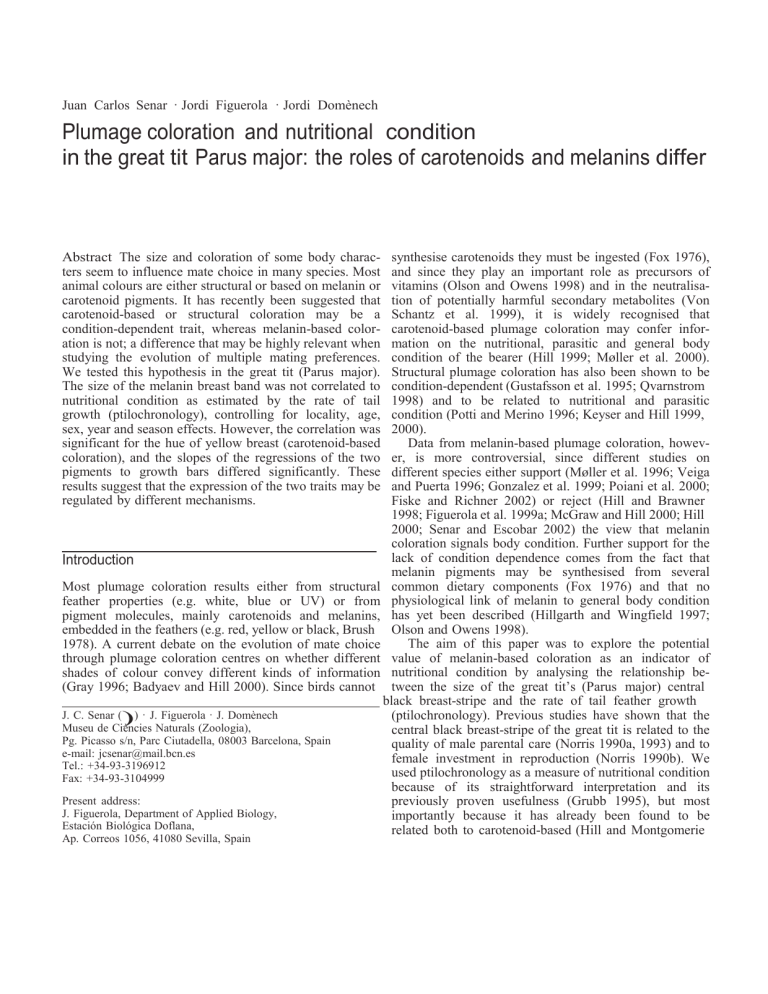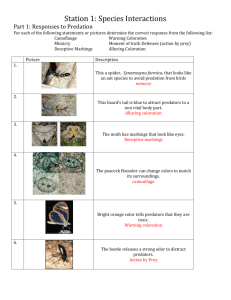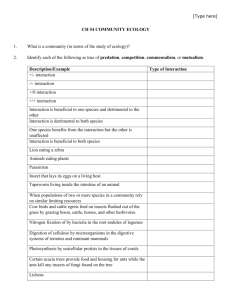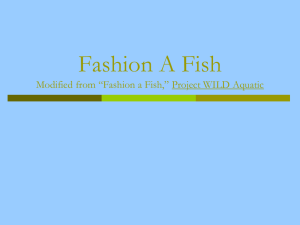Naturwissenschaften (2003) 90:234–237 - digital

Juan Carlos Senar · Jordi Figuerola · Jordi Domènech
Plumage coloration and nutritional condition in the great tit Parus major: the roles of carotenoids and melanins differ
Abstract The size and coloration of some body charac- ters seem to influence mate choice in many species. Most animal colours are either structural or based on melanin or carotenoid pigments. It has recently been suggested that carotenoid-based or structural coloration may be a condition-dependent trait, whereas melanin-based color- ation is not; a difference that may be highly relevant when studying the evolution of multiple mating preferences.
We tested this hypothesis in the great tit (Parus major).
The size of the melanin breast band was not correlated to nutritional condition as estimated by the rate of tail growth (ptilochronology), controlling for locality, age, sex, year and season effects. However, the correlation was significant for the hue of yellow breast (carotenoid-based coloration), and the slopes of the regressions of the two pigments to growth bars differed significantly. These results suggest that the expression of the two traits may be regulated by different mechanisms.
synthesise carotenoids they must be ingested (Fox 1976), and since they play an important role as precursors of vitamins (Olson and Owens 1998) and in the neutralisa- tion of potentially harmful secondary metabolites (Von
Schantz et al. 1999), it is widely recognised that carotenoid-based plumage coloration may confer infor- mation on the nutritional, parasitic and general body condition of the bearer (Hill 1999; Møller et al. 2000).
Structural plumage coloration has also been shown to be condition-dependent (Gustafsson et al. 1995; Qvarnstrom
1998) and to be related to nutritional and parasitic condition (Potti and Merino 1996; Keyser and Hill 1999,
2000).
Data from melanin-based plumage coloration, howev- er, is more controversial, since different studies on different species either support (Møller et al. 1996; Veiga and Puerta 1996; Gonzalez et al. 1999; Poiani et al. 2000;
Fiske and Richner 2002) or reject (Hill and Brawner
1998; Figuerola et al. 1999a; McGraw and Hill 2000; Hill
2000; Senar and Escobar 2002) the view that melanin coloration signals body condition. Further support for the lack of condition dependence comes from the fact that
Introduction
Most plumage coloration results either from structural feather properties (e.g. white, blue or UV) or from pigment molecules, mainly carotenoids and melanins, embedded in the feathers (e.g. red, yellow or black, Brush melanin pigments may be synthesised from several common dietary components (Fox 1976) and that no physiological link of melanin to general body condition has yet been described (Hillgarth and Wingfield 1997;
1978). A current debate on the evolution of mate choice through plumage coloration centres on whether different shades of colour convey different kinds of information
Olson and Owens 1998).
The aim of this paper was to explore the potential value of melanin-based coloration as an indicator of nutritional condition by analysing the relationship be-
(Gray 1996; Badyaev and Hill 2000). Since birds cannot tween the size of the great tit’s (Parus major) central
black breast-stripe and the rate of tail feather growth
J. C. Senar ( ) ) · J. Figuerola · J. Domènech
Museu de Ciències Naturals (Zoologia),
Pg. Picasso s/n, Parc Ciutadella, 08003 Barcelona, Spain e-mail: jcsenar@mail.bcn.es
Tel.: +34-93-3196912
Fax: +34-93-3104999
Present address:
J. Figuerola, Department of Applied Biology,
Estación Biológica Doflana,
Ap. Correos 1056, 41080 Sevilla, Spain
(ptilochronology). Previous studies have shown that the central black breast-stripe of the great tit is related to the quality of male parental care (Norris 1990a, 1993) and to female investment in reproduction (Norris 1990b). We used ptilochronology as a measure of nutritional condition because of its straightforward interpretation and its previously proven usefulness (Grubb 1995), but most importantly because it has already been found to be related both to carotenoid-based (Hill and Montgomerie
1994) and structural (Keyser and Hill 1999) colorations; this would thus allow, for the first time, a comparison of the three kinds of coloration within the same frame of reference.
Materials and methods
Great tits were captured in baited funnel traps from 1997 to 2000, in two contrasted areas near Barcelona, north-eastern Spain, situated approximately 10 km apart but with no exchange of birds. Age was determined according to the method of Jenni and Winkler (1994).
The size of the melanin-based black breast band was measured on digital photographs (n=144) with Image Tool software (for more technical details see Figuerola and Senar 2000). Measurement repeatability (measured as intra-class correlation) was r i
=0.98,
P<0.001, n=12 (see Figuerola and Senar 2000). General yellowish plumage coloration on the breast was measured with a Minolta
CR200 colorimeter (Minolta Corporation 1994) using a standard
D65 light flash (n=221, see Figuerola et al. 1999b). Colour was characterised according to the tri-stimulus variables of hue, chroma and lightness. The repeatability of the three colour variables was high (lightness, r i
=0.85, P<0.001; chroma, r i
=0.87, P<0.001; hue, r i
=0.92, P<0.001; n=12; Figuerola et al. 1999b). Two data point outliers were discarded from analyses because of a very low value of hue (<75°) which was probably due to an error in measurement, although the results still hold if they are retained. We did not measure the extent of yellow coloration in the breast because the whole area is generally covered in yellow, rendering this measure- ment impractical.
We used tail ptilochronology to estimate the conditions of food availability and nutritional condition experienced by birds during feather growth (Grubb 1995). The second pair of rectrices was plucked for further measurement in the laboratory, where the same observer measured the width of the first ten measurable distal growth bars to the nearest 0.1 mm (see Carrascal et al. 1998). This value was transformed by dividing by ten to obtained daily growth rate (mm/day) and averaging the values for the left and right rectrices. Measurement repeatability was r i
=0.99, P<0.001, n=15.
We measured the first ten measurable growth bars rather than following the standard technique (Grubb 1989) because the length of the great tit feather very often would not allow for measuring ten bands. Since great tits only moult in the autumn (Jenni and Winkler
1994), rectrices and contour feathers were moulted during the same period. Since yellow and black breast feathers belong to the same feather tract, they are moulted within the same time period (Gosler
1993).
Results
Breast band size was not correlated to the tri-stimulus variables of yellow breast coloration (lightness, r=0.07,
P=0.43; chroma, r=0.07, P<0.45; hue, r=0.002, P<0.98; n=144; standardising by age, sex and locality).
Width of tail growth bars was positively correlated with hue of the yellow coloration of the breast (Table 1,
Fig. 1). However, width of growth bars was not correlated with the melanin-based breast band size (Table 1, age, sex, locality, year and months from moult controlled in a
MANCOVA with the three colour variables and breast band size as dependent variables and width of the growth bars and months since moult entered as covariates).
The two regressions of growth bars to either hue of the yellow breast and size of the black breast band signifi- cantly differed in slopes (parallelism test, F
1,352
=4.42,
235
Table 1 MANCOVA analysing the relationships of tail feather growth rate as measured from ptilochronology (i.e. nutritional condition) to lightness, intensity and hue of the carotenoid-derived yellow coloration of the breast and size of the melanin-derived black breast band of great tits, controlling for the effects of age, sex, locality, year and months since moult. Multivariate tests: overall regression Wilks’ l=0.84, P=0.01; fixed effects: age Wilks’ l=0.78,
P<0.001, sex Wilks’ l=0.35, P<0.001, locality Wilks’ l=0.85,
P=0.01, year Wilks’ l=0.36, P<0.001. Slopes are standardized to mean = 0 and SD=1
Slope (beta)
Ptilochronology
Yellow lightness
Yellow intensity
Yellow hue
Black breast band size
—0.12
0.00
0.20
0.05
Months since moult
Yellow lightness
Yellow intensity
Fixed effects
Age
—0.16
—0.22
Yellow hue
—0.18
Black breast band size —0.13
t
115
P
1.25
0.21
0.02
0.98
2.22
0.03
0.51
0.61
1.70
0.09
2.42
0.02
1.99
0.05
1.36
0.18
Yellow lightness 0.67 0.41
Yellow intensity 14.14 <0.001
Yellow hue 15.37 <0.001
Black breast band size 8.23 <0.01
Sex
Yellow lightness 12.44 <0.001
Yellow intensity 0.64 0.42
Yellow hue 0.25 0.62
Black breast band size 207.54 <0.001
Locality
Yellow lightness 0.11 0.74
Yellow intensity 7.35 <0.01
Yellow hue 12.18 <0.001
Black breast band size 0.11 0.74
Year
Yellow lightness 3.25 0.02
Yellow intensity 3.18 0.03
Yellow hue 25.28 <0.001
Black breast band size 12.96 <0.001
P=0.04, controlling for age, sex and locality, including the whole data set). This shows that melanin-based coloration is less important than carotenoid-based color- ation in relation to growth.
Discussion
Condition dependence is critical to the understanding of ornament evolution (Pomiankowski 1987). Ptilochronol- ogy (Grubb 1995) is a robust approach to testing the condition-signalling role of plumage, since it directly links foraging success to the expression of plumage coloration (Hill and Montgomerie 1994). Here we have shown that the width of the great tit melanin-based breast stripe was not related to feather growth rates. However, yellow carotenoid coloration (hue) of the breast was
236
Fig. 1 Relationship between tail feather growth rate, as measured from width of growth bars (ptilochronology) and A hue of the yellow carotenoid-based coloration of the breast as obtained from colorimetry, and B size of the melanin-based breast band of the great tit, as obtained from digital photography significantly related to feather growth rates. The discrep- ancy between our results and those of Eeva et al. (1998) is probably related to the greater repeatability and precision of our colour measurements, where the slopes of the two regressions (carotenoid and melanin) differed significant- ly. This supports the hypothesis that melanin-based coloration is not a good candidate for signalling nutri- tional condition, and that melanin- and carotenoid-based colorations might serve fundamentally different functions
(Gray 1996; Badyaev and Hill 2000).
The main source of carotenes for tits are caterpillars
(Slagsvold and Lifjeld 1985). Once ingested, carotenes are deposited unmodified in the feathers of tits (Partali et al. 1987). A brightly carotene-coloured great tit may therefore be directly signalling its ability to find caterpil- lars, a main food source for both adults and fledglings
(Gosler 1993). Our data relating width of tail growth bars to yellow hue supports this higher foraging efficiency of more brightly coloured tits. Hence, it would be of direct female benefit to pair with a very yellow great tit male
(see Senar et al. 2002). The study of tits could therefore neatly solve the missing link in other bird studies in relation to the question of why finding carotenes may be difficult but nevertheless highly advantageous in order to acquire a mate.
Acknowledgements We are very grateful to Lluisa Arroyo, David
Boné and Iker Ruiz for field assistance, and to Miguel Tejedo for laboratory facilities. This work was funded by Ministerio de
Ciéncia y TecnologIa (BOS 2000-0141).
References
Badyaev AV, Hill GE (2000) Evolution of sexual dichromatism: contribution of carotenoid- versus melanin-based coloration.
Biol J Linn Soc 69:153–172
Brush AH (1978) Avian pigmentation. In: Brush AH (ed) Chemical zoology, vol. X: Aves. Academic Press, New York, pp 141–161
Carrascal LM, Senar JC, Mozetich I, Uribe F, Domènech J (1998)
Interactions among environmental stress, body condition, nutritional status, and dominance in great tits. Auk 115:727–
738
Eeva T, Lehikoinen E, Ronkä M (1998) Air pollution fades the plumage of the great tit. Funct Ecol 12:607–612
Figuerola J, Senar JC (2000) Measurement of plumage badges: an evaluation of methods used in the great tit Parus major. Ibis
142:482–484
Figuerola J, Mufloz E, Gutiérrez R, Ferrer D (1999a) Blood parasites, leucocytes and plumage brightness in the cirl bunting
Emberiza cirlus. Funct Ecol 13:594–601
Figuerola J, Pascual J, Senar JC (1999b) The use of a colorimeter in field studies of blue tit Parus caeruleus coloration. Ardea
87:269–275
Fiske PS, Richner H (2002) Differential effects of a parasite on ornamental structures based on melanins and carotenoids.
Behav Ecol 13:401–407
Fox DL (1976) Animal biochromes and structural colours.
University of California Press, Berkeley, Calif.
Gonzalez G, Sorci G, Lope F (1999) Seasonal variation in the relationship between cellular immune response and badge size in male house sparrows (Passer domesticus). Behav Ecol
Sociobiol 46:117–122
Gosler AG (1993) The great tit. Hamlyn, London
Gray DA (1996) Carotenoids and sexual dichromatism in North
American passerine birds. Am Nat 148:453–480
Grubb TC (1989) Ptilochronology: feather growth bars as indicators of nutritional status. Auk 106:314–320
Grubb TC (1995) Ptilochronology: a review and prospectus. Curr
Ornithol 12:89–114
Gustafsson L, Qvarnstrom A, Sheldon BC (1995) Trade-offs between life-history traits and a secondary sexual character in male collared flycatchers. Nature 375:311–313
Hill GE (1999) Mate choice, male quality, and carotenoid-based plumage coloration. In: Adams N, Slotow R (eds) Proceedings of the 22nd international ornithological congress, Durban.
BirdLife South Africa, Johannesburg, pp 1654–1668
Hill GE (2000) Energetic constraints on expression of carotenoidbased plumage coloration. J Avian Biol 31:559–566
Hill GE, Brawner WR (1998) Melanin-based plumage coloration in the house finch is unaffected by coccidial infection. Proc R Soc
Lond B 265:1105–1109
Hill GE, Montgomerie R (1994) Plumage colour signals nutritional condition in the house finch. Proc R Soc Lond B 258:47–52
Hillgarth N, Wingfield JC (1997) Parasite-mediated sexual selection: endocrine aspects. In: Clayton DH, Moore J (eds) Host– parasite evolution: general principles and avian models. Oxford
University Press, Oxford, pp 78–103
Jenni L, Winkler R (1994) Moult and ageing of European passerines. Academic Press, London
Keyser AJ, Hill GE (1999) Condition-dependent variation in the blue–ultraviolet coloration of a structurally based plumage ornament. Proc R Soc Lond B 266:771–777
Keyser AJ, Hill GE (2000) Structurally based plumage coloration is an honest signal of quality in male blue grosbeaks. Behav Ecol
10:202–209
McGraw KJ, Hill GE (2000) Differential effects of endoparasitism on the expression of carotenoid- and melanin-based ornamental coloration. Proc R Soc Lond B 267:1525–1531
Minolta Corporation (1994) Precise color communication: color control from feeling to instrumentation. Minolta Corporation,
Osaka, Japan
Møller AP, Kimball RT, Erritzoe J (1996) Sexual ornamentation, condition, and immune defence in the house sparrow Passer domesticus. Behav Ecol Sociobiol 39:317–322
Møller AP, Biard C, Blount JD, Houston DC, Ninni P, Saino N,
Surai PF (2000) Carotenoid-dependent signals: indicators of foraging efficiency, immunocompetence or detoxification ability? Avian Poult Biol Rev 11:137–159
Norris KJ (1990a) Female choice and the evolution of the conspicuous plumage coloration of monogamous male great tits. Behav Ecol Sociobiol 26:129–138
Norris KJ (1990b) Female choice and the quality of parental care in the great tit Parus major. Behav Ecol Sociobiol 27:275–281
Norris KJ (1993) Heritable variation in a plumage indicator of viability in male great tits Parus major. Nature 362:537–539
Olson VA, Owens IPF (1998) Costly sexual signals: are carotenoids rare, risky or required? Trends Ecol Evol 13:510–514
Partali V, Liaaen-Jensen S, Slagsvold T, Lifjeld JT (1987)
Carotenoids in food chain studies. II. The food chain of Parus spp. monitored by carotenoid analysis. Comp Biochem Physiol
87B:885–888
Poiani A, Goldsmith AR, Evans MR (2000) Ectoparasites of house sparrows (Passer domesticus): an experimental test of the
237 immunocompetence handicap hypothesis and a new model.
Behav Ecol Sociobiol 47:230–242
Pomiankowski A (1987) Sexual selection: the handicap principle does work – sometimes. Proc R Soc Lond B 231:123–145
Potti J, Merino S (1996) Decreased levels of blood trypanosome infection correlate with female expression of a male secondary sexual trait: implications for sexual selection. Proc R Soc Lond
B 263:1199–1204
Qvarnstrom A (1998) Sexual selection in the collared flycatcher
(Ficedula albicollis): a life-history perspective. PhD thesis,
Uppsala University, Sweden
Senar JC, Escobar D (2002) Carotenoid-derived plumage coloration in the siskin Carduelis spinus is related to foraging ability.
Avian Sci 2:19–24
Senar JC, Figuerola J, Pascual J (2002) Brighter yellow blue tits make better parents. Proc R Soc Lond B 269:257–261
Slagsvold T, Lifjeld JT (1985) Variation in plumage colour of the great tit Parus major in relation to habitat, season and food. J
Zool 206:321–328
Veiga JP, Puerta M (1996) Nutritional constraints determine the expression of a sexual trait in the house sparrow, Passer domesticus. Proc R Soc Lond B 263:229–234
Von Schantz T, Bensch S, Grahn M, Hasselquist D, Wittzell H
(1999) Good genes, oxidative stress and condition-dependent sexual signals. Proc R Soc Lond B 266:1–12








